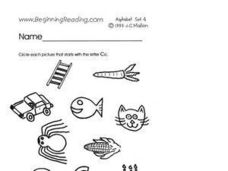Curated OER
Beginning Reading: Words That Start With B
In this words that start with B worksheet, young scholars evaluate 10 pictures. Students then circle the pictures that start with the letter B.
Curated OER
Beginning Reading: Words That Start With E
In this words that start with E worksheet, students view 10 pictures on the worksheet. They then determine which ones start with the letter E and circle them.
Curated OER
Beginning Reading: Words That Start With C
In this words that start with C learning exercise, students view 10 pictures on the learning exercise. They then determine which ones begin with the letter C and circle them.
K12 Reader
The Pot is Hot
What do a pot and a robot have in common? They both end in -ot! Kids practice their -ot words by reading the short poem included here and then tap into reading comprehension skills by answering the three questions.
K5 Learning
The Parade
Parades are a joy to watch and learn about. Class members read about a child who attended a parade with her mother and brother, match past tense verbs from the reading, identify and fill in blanks for sight words candy,...
Curated OER
Beginning Reading
Beginning readers look at the six pictures provided and circle the word that correctly describes the picture. There are ony two word choices for each picture, but they sound similar, making it difficult for some learners.
ReadWriteThink
Literature Circles: Getting Started
Make reading more enjoyable and interactive with literature circles! Here you'll find detailed lessons to begin the literature circle process. Ten lessons introduce each role learners take on. Literature circle roles include...
Math Mammoth
Measuring Angles
The first of two pages displays various angles as the measure of degrees of a circular arc. An explanation is written, and learners are asked to model each by holding up two pencils as the rays. The second page provides instruction on...
K12 Reader
Kinds of Angles
Have you ever wondered how circles and angles relate to each other? Read a passage about right angles, acute angles, and obtuse angles, and answer reading comprehension questions about the information you learn.
K12 Reader
Shapes on a Plane
Geometric shapes are the focus of a comprehension exercise that asks readers to examine a short passage about planes, circles, triangles, and rectangles, and then to respond to a series of questions about the article.
K12 Reader
Where On Earth Are You?
What do we use to determine the exact locations on the earth? Your kids can learn all about compass roses and latitude and longitude. Test understanding with the five reading comprehension questions included on the page.
K12 Reader
What’s Your Angle?
Start out with angles by asking your pupils to read this reading passage. Class members will learn about degrees, right angles, acute angles, and obtuse angles and then respond to five questions about the text.
Curated OER
Find the Words
Before kids become readers, they can build foundational pre-reading skills using visual worksheets like this one. Learners examine six words with corresponding pictures, circling the words and guessing what they say. They use the images...
Florida Center for Reading Research
Rhyme Pie
Being able to recognize rhyming words is a step closer to understanding the phonemic blends that are necessary for building early reading skills. Little learners use the provided picture cards to make a rhyming pie. They glue rhyming...
Curated OER
Around the Clock
Young scholars discover the relationship between the circumference of a circle and its diameter. They find the length of an arc of a circle.Students use estimation strategies in real-world applications to predict results (i.e.,...
K12 Reader
Phases of the Moon
Take one giant leap for mankind with a reading passage about the moon. Kids learn about the lunar cycle with context clues and reading comprehension questions, making it a good informational text for your language arts lesson.
Curated OER
Gettin' Through Thursday
Have your class explore active reading strategies! For this guided reading lesson, learners make personal connections to characters having a bad day as a prior knowledge activation discussion. After reading Gettin' Through Thursday,...
K5 Learning
Sharks
"Dun dun... dun dun." A shark! After second graders read a four-paragraph passage about sharks, they respond to four reading comprehension questions that use the text as a basis for the answers.
K5 Learning
Why Does the Ocean have Waves?
Six short answer questions challenge scholars to show what they know after reading an informational text that examines waves—what they are, what causes them, and how different Earth factors affect their size and strength.
K12 Reader
The Man Has a Can
Add this -an word resource into your plan for the day! Kids can read the poem, which includes several -an words to practice with, and then answer the three included reading comprehension questions.
K12 Reader
Shut the Hut
Go with your gut and try out this worksheet that focuses on -ut words! Learners read a brief poem that includes many different words that end in -ut and then respond to three reading comprehension questions.
K12 Reader
Two Hens in a Pen
Make a study of -en words with this exercise. Class members first read a short poem that incorporates many -en words. They then respond to three included reading comprehension questions about the passage.
K12 Reader
Will You Stay and Play?
Start off your day with a study of -ay words. Pupils can practice long a with -ay words by reading the brief poem included here. After they read, class members answer three reading comprehension questions right on the page.
K12 Reader
He Must Take the Bus
Build your youngsters' knowledge of the short /u/ sound with a quick exercise. Class members read a brief poem designed to include many words with the short /u/ sound and then answer three reading comprehension questions about...

























